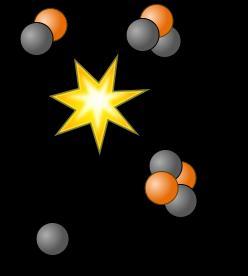
2 minute read
3.3.1 Fundamental conception
energy for nuclear power and to drive the explosion of nuclear weapons. Both uses are possible because certain substances called nuclear fuels undergo fission when struck by fission neutrons, and in turn emit neutrons when they break apart. This makes possible a self-sustaining nuclear chain reaction that releases energy at a controlled rate in a nuclear reactor or at a very rapid uncontrolled rate in a nuclear weapon.
Fig3.2: The stages of binary fission in a liquid drop model. Energy
input deforms the nucleus into a fat "cigar" shape, then a "peanut" shape, followed by binary fission as the two lobes exceed the short-range strong force attraction distance, then are pushed apart and away by their electrical charge. Note that in this model, the two fission fragments are the same size.
The amount of free energy contained in nuclear fuel is millions of times the amount of free energy contained in a similar mass of chemical fuel such as gasoline, making nuclear fission a very dense source of energy. The products of nuclear fission, however, are on average far more radioactive than the heavy elements which are normally fissioned as fuel, and remain so for significant amounts of time, giving rise to a nuclear waste problem. Concerns over nuclear waste accumulation and over the destructive potential of nuclear weapons may counterbalance the desirable qualities of fission as an energy source, and give rise to ongoing political debate over nuclear power.
In nuclear physics, nuclear fusion is a nuclear reaction in which two or more atomic nuclei collide at very high speed and join to form a new type of atomic nucleus (e.g. The energy that the Sun emits into space is produced by nuclear reactions that happen in its core due to the collision of hydrogen nuclei and the formation of helium nuclei). During this process, matter is not conserved because some of the mass of the fusing nuclei is converted to photons which are released through a cycle that even our sun uses. Fusion is the process that powers active stars.
The fusion of two nuclei with lower masses than iron (which, along with nickel, has the largest binding energy per nucleon) generally releases energy, while the fusion of nuclei heavier than iron absorbs energy. The opposite is true for the reverse process, nuclear fission. This means that fusion generally occurs for lighter elements only, and likewise, that fission normally occurs only for heavier elements.
There are extreme astrophysical events that can lead to short periods of fusion with heavier nuclei. This is the process that gives rise to nucleosynthesis, the creation of the heavy elements during events such as supernovae.
Fig3.3: Fusion of deuterium with tritium creating helium-4, freeing a
neutron, and releasing 17.59 MeV of energy, as an appropriate amount of mass






